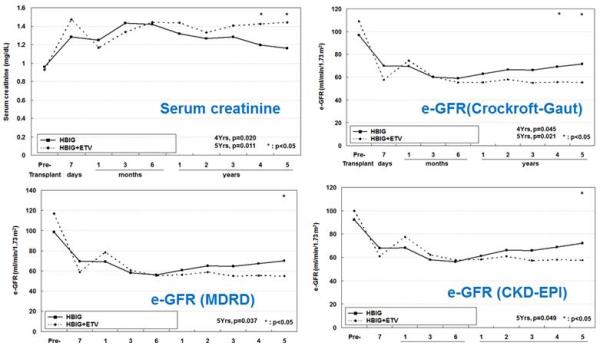Benefit of Anti-hepatitis B Immunoglobulin(HBIG) Monotherapy Compared to HBIG Combined with Entecavir in Long Term Renal Function
Jae Geun Lee1, Deok Gie Kim1, Jung Jun Lee2, Sung Hoon Kim3, Seung Hwan Song4, Jee Youn Lee1, Myoung Soo Kim1, Man Ki Ju1, Gi Hong Choi1, Jin Sub Choi1, Soon Il Kim1, Dong Jin Joo1.
1Department of Surgery, Yonsei University College of Medicine, Seoul, Korea; 2Department of Surgery, CHA Bundang Medical Center, Seoul, Korea; 3Department of Surgery, Yonsei University Wonju College of Medicine, Wonju, Korea; 4Department of Surgery, Ewha Woman’s University College of Medicine, Seoul, Korea
Background: To reduce the HBV reinfection after liver transplantation, anti-hepatitis B immunoglobulin (HBIG) alone or combination with antiviral nucleotide analogues are usually used regimen. However, antiviral nucleotide analogues have nephrotoxicity, which is a critical issue because renal dysfunction frequently happens after liver transplantation.
Method: Medical records of 171 liver recipients with HBV who underwent liver transplantation between Sep. 2005 and Dec. 2012 were retrospectively reviewed. The difference of renal function of HBIG mono-therapy group (HBIG) and HBIG combined with Entecavir group (HBIG+ETV) were analyzed.
Results: There was no significant difference in age, gender, body mass index, intraoperative blood loss, and MELD score between the two groups. But the patients who had preoperative ascites, mean preoperative AST level, preoperative GFR level, and the applying event of CRRT was significantly different between the groups. The decrease of eGFR between preoperative and 1 year after transplantation was 31.5±27.2 mL/min/1.73m2 (p<0.001), in HBIG group and 40.0±45.9 mL/min/1.73m2 (p<0.001) in HBIG+ETV group. Also, the eGFR decrease between preoperative and 4-year after transplantation was 24.5±29.9 mL/min/1.73m2 (p<0.001) in HBIG group and 38.9±56.8 mL/min/1.73m2 (p<0.001) in HBIG+ETV group.
Conclusion: There was no difference of recurrence rate of HBV. However, HBIG+ETV combination regimen showed more declination of eGFR in long-term period after liver transplantation than HBIG alone.

